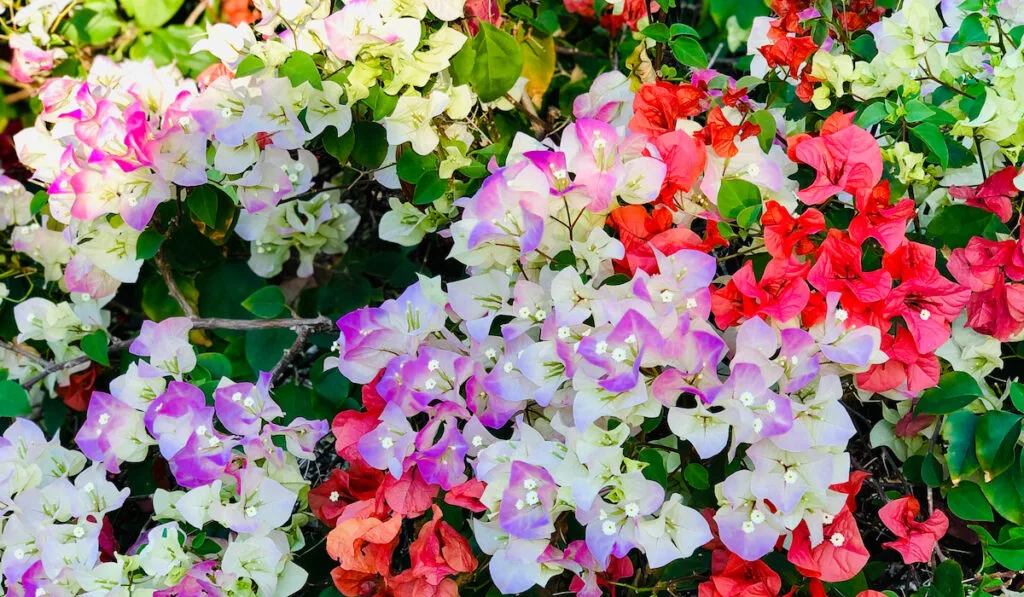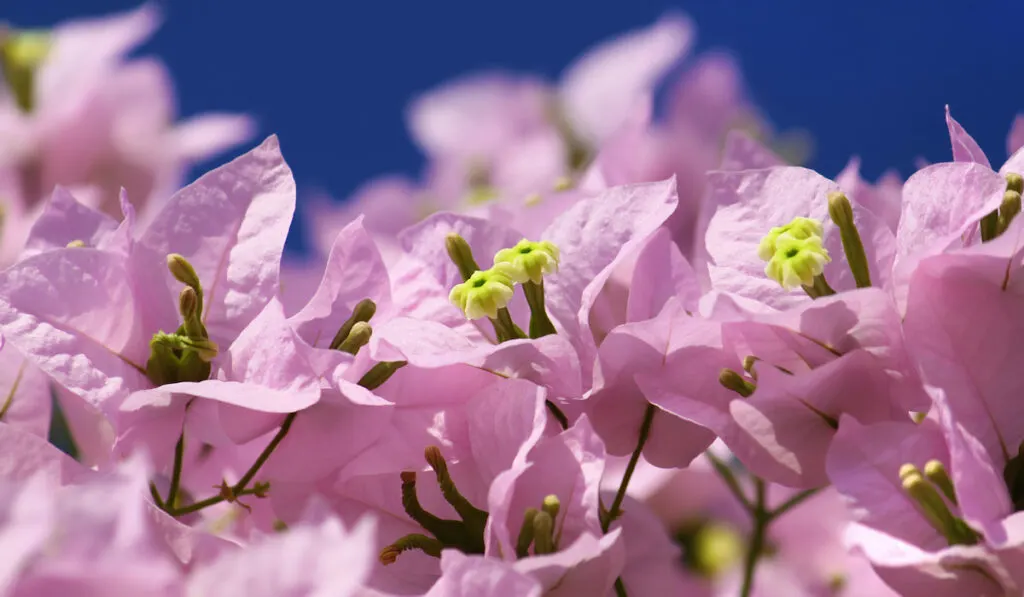Bougainvilleas are distinctive, ornamental plants that come in many colors and varieties. They are woody vines with strong thorns, bright green foliage, and eye-catching flowers.
Bougainvillea thrives in tropical and subtropical climates, and you can find it all over the world. In some cultures, Bougainvillea is a symbol of peace, and it is Grenada’s national flower.
To discover more about this charming, hardy plant, take a look at these nine fascinating facts about Bougainvillea below.

Table of Contents
Fact #1 – Bougainvillea Comes From South America
Bougainvillea is a tropical vine native to South America and is part of the 4 o’clock vine (Nyctaginaceae) family.
French botanist, Philibert Commerçon, was the first person to record Bougainvillea when he discovered it in Rio de Janeiro, Brazil, in the 1760s.
Commerçon named the vine after Loui-Antoine de Bougainville, a French admiral with whom he shared many expeditions — and they introduced the plant to Europe.
Bougainvillea thrived in the Mediterranean climate, particularly in Spain, and it quickly spread to other tropical areas such as China, India, Hawaii, and Australia.
Fact #2 – They’re Easy to Grow and Maintain

In the correct climate, Bougainvilleas are incredibly hardy. They thrive in US grow zones 9 to 11, but you can grow them in containers and bring them indoors during the winter in cold areas.
The tropical vine prefers moist, well-draining, loamy soil and is drought tolerant, but during dry periods, it won’t thrive and bloom and may shed its leaves.
The soil must drain well because too much moisture will encourage excessive foliage growth and may cause root rot, which can kill the plant.
Bougainvilleas are pest resistant but can be susceptible to snails, worms, and some moth larvae.
The ideal time to prune Bougainvilleas is after flowering or in late winter or early spring.
You must wear gloves and long clothing for pruning because the thorns are hard and will scratch the skin.
Fact #3 – There Are Many Species and Varieties

Bougainvillea has many aliases—Paper Flower, Napoleón, Veranera, Trinitaria, Santa Rita and Papelillo.
There are also many species and varieties of Bougainvillea – and botanists and hobby gardeners regularly create new hybrid variations.
There are as many as 18 Bougainvillea plant species, but most botanists recognize only 3 as originals — B. spectabilis, B. glabra and B. peruviana.
There are over 300 varieties of Bougainvillea — and some of the most common ones are the ‘San Diego Red’, ‘Texas Dawn’, ‘Raspberry Ice’, ‘Jamaica White’, ‘Barbara Karst’, and ‘Gold Rush’.
Each species is different, so you must research to find the one most suitable for your garden and climate.
Fact #4 – The Flowers Aren’t Flowers

The most distinctive thing about Bougainvillea is its beautiful, colorful flowers.
Like the poinsettia or dogwood, the colored petals of the Bougainvillea plant aren’t flowers—they’re bracts. The flower is tiny and white and sits deep in the bract center.
Each stem node produces three flowers, so Bougainvillea is a densely packed plant and will attract pollinators into the garden.
The papery bracts come in many bright, distinctive colors, including many shades of pink, purple, and gold. The bracts are darker or paler depending on the plant’s age and environment.
In perfect conditions, the ornamental vine will bloom repeatedly throughout the year, and flowers will last between 3 and 5 weeks.
Fact #5 – They Can Be Evergreen or Deciduous
Bougainvillea can be an evergreen or deciduous plant, depending on its environment.
The vine will remain green all year in tropical areas, but in cool climates, it will lose its leaves and become dormant in the winter.
Heavy frost can kill Bougainvillea, so in cold climates you must keep it in a pot — and bring it indoors for the winter and ensure it gets plenty of light.
Fact #6 – Bougainvilleas Love the Sun

Bougainvilleas are sun-loving plants and won’t flower in the shade. They need full sun for at least 5 hours per day, ideally 8 hours, to flower.
The blooms will have more or less color depending on how much light they receive.
The vine will grow in partial shade, but it will produce more foliage and few blooms. With less than 4 hours of sunlight, there’s a chance the plant will shed its leaves.
Bougainvilleas love high temperatures and will thrive in heat or sunlight-reflective areas.
Fact #7 – Bougainvillea Flowers Are Edible

The flowers of the Bougainvillea plant are edible, and you can eat them raw in salads, deep fry them tempura-style or use them to decorate drinks and the color seeps into the water.
You can also make Bougainvillea tea with flowers, which has a delicate taste and soothing effect on the respiratory and digestive systems.
In South America, Bougainvillea has a long history of medicinal use. Traditionally, natives use the plant for coughs and chest complaints.
According to this study, Bougainvillea has many medicinal properties, it is analgesic, anti-inflammatory, antimicrobial, antioxidant, and antifertility, to name just a few.
Another study reports that it may even help fight cancer and heart disease.
Never consume the leaves, stems, or roots because the sap is toxic and can cause mild irritation.
Fact #9 – Bougainvilleas Are Versatile

These beautiful plants are incredibly versatile and come in many forms.
Bougainvilleas can be tall vines, dense bushes or even dwarf versions of these forms, and they grow between 3 to 39ft (1 to 12m) tall.
Bougainvillea is a climber, but it’s not a clinging vine, so you must tie it back or give it support and be aware that it will grow over other plants.
You can grow the vine in pots as bonsai, in hanging baskets, containers, on trellises, over walls, or on pergolas. They can provide ground cover and help keep weeds down.
Bougainvillea Care Tips
In the correct conditions, Bougainvilleas are hardy plants. They are pests, disease, and drought resistant and don’t have complicated nutritional needs.
Bougainvillea will thrive in tropical environments with little maintenance, but if you want colorful, dense blooms, here are a few care tips to help you get the most from your vine:
- Soil – Use fertile, well-draining, loamy soil with a pH slightly above 6.
- Water – Bougainvilleas prefer occasional deep watering to frequent shallow ones.
Let the plant dry out before watering. As a rule, water when the top inch or two is dry. The water requirements will vary depending on the season.
- Fertilizer – Outdoor Bougainvilleas don’t have many nutritional needs and usually get by with a fresh layer of compost twice a year.
Potted plants need a balanced, slow-release or organic fertilizer every two to three months.
- Pruning – Light pruning is the best way to promote new growth. Prune dead flowers after each bloom, and don’t prune too close to spring.
- Pests – No plant is immune from pests, and though they are pest-resistant, Bougainvillea sometimes suffers from aphids and caterpillars, snails, slugs, and mealworms.
- Planting – Plant in spring or early summer in the sunniest spot in the garden.

Summary
Bougainvilleas are native to South America and love being in the sun. Without enough sunlight, the vine won’t bloom.
The bright, distinctive, papery flowers of the Bougainvillea aren’t actually flowers—they are bracts. The tiny white flower sits inside the bract.
The best climate for Bougainvillea is tropical to subtropical. They thrive in growing zones 9 to 11, but you can grow them in cool areas if you winter them indoors.
Resources
- https://plantcaretoday.com/bougainvillea-pest.html
- https://finom.co.nz/blogs/finomnom/beautiful-bougainvillea
- https://www.edenproject.com/visit/things-to-do/mediterranean-biome/bougainvillea
- https://tenrandomfacts.com/bougainvillea/
- https://www.eattheweeds.com/bougainvillea/
- https://www.gardenguides.com/94639-different-colors-bougainvillea-flowers.html
- https://www.joyusgarden.com/bougainvillea-tips-and-facts/
- https://www.joyusgarden.com/care-growing-tips-bougainvillea/
- https://www.gardendesign.com/vines/bougainvillea.html
- https://www.westdalenurseries.co.uk/history-of-bougainvillea/
- https://www.gardenguides.com/138463-train-bougainvillea-vine.html
- https://katosnursery.com/bougainvillea-secrets/
- https://www.uselessdaily.com/world/bougainvillea-trivia-30-facts-about-the-beautiful-flower/
- https://hgic.clemson.edu/factsheet/bougainvillea-2/
- https://itsnevernotteatime.com/what-is-bougainvillea-tea-and-its-benefits/
- https://gardenerspath.com/plants/vines/grow-bougainvillea/
- https://www.britannica.com/plant/bougainvillea
- https://www.bachmans.com/information/care-advice/bougainvilleas
- https://gardenforbeginners.com/care-and-feeding-of-bougainvillea-what-is-the-best-fertilizer/
- https://ejmcm.com/article_9689_023bcdb622db65d2f020e9aabac389d0.pdf
